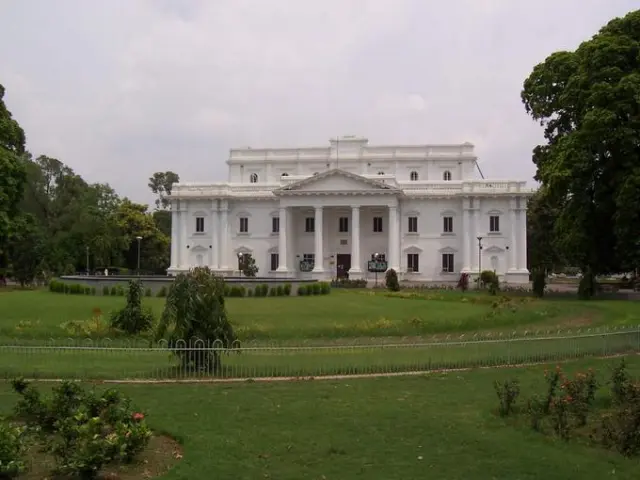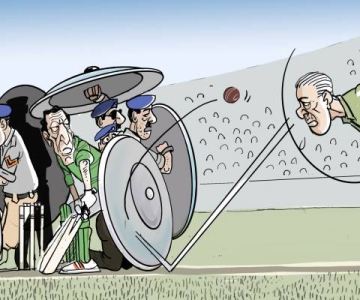Essences of the past and present come alive at the Lawrence Gardens
Lahores Lawrence Gardens, baptised the Bagh-i-Jinnah in the post-independence era, represent the quintessential Raj ethos. Built primarily for the sahibs and memsahibs , the park has managed to maintain its dream-like beauty for a century and a half. The colonial maps drawn up in the mid-nineteenth century show that eastward of Charing Cross, Gardens existed on the right. In the place of the Freemasons Hall, there was once a circular garden; and what is now the Lahore Zoo was another park called the New Garden. This was followed by the Agricultural and Horticultural Society Garden, which was the original name of the city beloved Lawrence Gardens. The Agriculture Horticulture Society of India established it in 1860 and years later, in 1904, the department of agriculture assumed maintenance responsibilities. Since 1912, approximately seven acres of the park have been managed by the Government College, Lahore; to this day, it maintains a delightful botanical garden replete with a greenhouse and experimental fields.
The annexation of the Punjab in 1849 and the successful control of the 1857 uprising in many regions of northern India resulted in the consolidation of the British Empire; due to its strategic location, the Punjab was central to the architecture of the colonial power. Lahore was to become a major outpost of the empire. Therefore, the sahibs had to create social and cultural spaces for themselves in otherwise unfriendly and unfamiliar surroundings. A garden in the heart of British Lahore was essential. True to the colonial policy, the new garden would be a continuation of the Mughal tradition of creating baaghs as the aesthetic expression of self-indulgence. This project, however, was to reflect the expanse of the Empire. Thousands of saplings of different exotic species were imported from many colonies around the world and by 1860, all the necessary preconditions such as identifying and acquiring hundreds of acres of land had been met.
It is believed that London’s Kew Gardens were the inspiration for the Lawrence Gardens and records suggest that that a leading gardener from London was brought to Lahore to oversee the work of local maalis and create a unique setting that has indeed retained its appeal over time.
The Lawrence Gardens were meant to refresh in the minds of sahibs and memsahibs the memory of the subliminal Kew atmosphere. In later years, the Kew Gardens have retained their importance: they were added to the list of World Heritage sites in 2003, in recognition of the historical landscapes and outstanding buildings as well as the research carried out there.
Lahoris owe a debt of gratitude to Majid Sheikh, the brilliant chronicler of Lahore, who keeps reminding us of Lahore’s links to the bygone eras. I have always been amazed at his ability to research and regularly present fresh perspectives on the city in a leading daily newspaper. According to Mr Sheikh, the daughter of Lahore’s Commissioner, Miss Forsyth, planted the first tree in 1860. She lived and died in Lahore.
The Lahore Gymkhana originated in the Lawrence Gardens, where a hall designed by chief engineer Mr G Stone was built. Clubs became integral to the lifestyle of the British as private retreats.
Over the decades, these clubs acquired a subculture of their own. Exclusion and selectivity prevailed even in the nineteenth century, when the soldiers and non-commissioned officers were not allowed access. Natives, of course, were excluded until the twentieth century and in some cases, until all the sahibs left for their humble lives ‘back home.’
Club addiction has carried on in the post-1947 elites and modern gymkhanas in Pakistan and India are still gateways to a prestige network. Small wonder, then, that when the 1965 war sparked off, the Indian commander-in-chief announced that he would enjoy his evening bara peg at the Lahore Gymkhana!
But I digress; Lawrence Gardens’ Hall, built around 1862, was expanded to house two buildings – the Lawrence Hall and the Montgomery Hall – named after the two governors of the Punjab, Sir John Lawrence and Sir Robert Montgomery. At a later point in time, the two structures were integrated into one. Later, Lawrence’s name was attached to the Gardens and Montgomery’s to the Hall.
Another Governor, General Jillani, had a sense of history and was keen to dilute the elitism inherent to his tribe. In 1984, he converted the Hall into a magnificent library dedicated to the Quaid-e-Azam. It is ironic that ordinary mortals still find it difficult to obtain membership at the library, and the highest percentage of users are aspirants towards the civil services! Some sociologists would remark that this is continuity of another kind…
The three main gates were originally called the Victoria Gate (on the Mall), the Rivaz Gate (on Lawrence Road) and the Montgomery Gate (on Racecourse Road). Time has erased these names and we will have to wait for a culturally correct administrator to revive these names – after all, losing history means losing a part of our collective selves.
It is in the gymkhana tradition that the cricket ground was built in the Gardens. The cricket ground has remained the hallmark of the Lawrence Gardens and the well-designed pavilion made from British oak-wood is a heritage site.
Of course, true to our contemporary aesthetic – or lack of it – another concrete replica was added some years ago. One of our former prime ministers frequently played cricket at the Baagh-e-Jinnah and every Sunday, modern day sahibs would play with him.
The tall trees that still overlook the ground remind us of the importance of our primordial relationship with nature that modernity continues to alter each passing day. Blake put it well: But to the eyes of the man of imagination, Nature is Imagination itself.
Trees symbolise both history and the future by promising regeneration. The Lawrence Gardens maintain a rich collection of rare trees and shrubs, both indigenous and exotic, with more than 6,000 trees. The speaking banyans, rustic keekars and shishams , mystical pipals , quiet oaks and the haunting camphors constitute the universe of the Gardens.
Easily noticeable amidst the trees are groups of vultures sunning themselves in their treetop roosts. Inspired by the setting, Urdu writer Bano Qudsia’s landmark novel Raja Gidh–the vulture king–has Lawrence Gardens at the centre of its bleak and puritan moral landscape.
Some years ago, again courtesy the inimitable Majid Sheikh, I learnt that while the British forces were camped on the grounds of the Lawrence Gardens, the memsahibs and their obedient staff – faced with the shortage of rations – invented the famous ‘club sandwich.’ Memsahibs had to do something with the limited supply of foodstuffs and ordered the minions to layer ingredients between slices of bread. The club sandwich is now widely available across South Asia and beyond; and by this account it owes its origin to Lahore and these Gardens.
The Lawrence Gardens also nurture two fabulous, manmade “hills,” which were probably brick kilns in the Mughal era. The famous principal of Lahore’s Government College, Mr Sondhi, contributed to the creation of an open air theatre where performances by the College dramatic society were often held.
The great artist Sadequain frequented this place for a few years in the 1970s, in order to paint some of his great works. For decades, it has been the venue for the All Pakistan Music Conference, held in the crisp spring air and the chill of early winter. Roshan Ara’s voice and the ambience must have made the place truly surreal.
With the passing away of the great patron of the Conference, the future of this event hangs in the balance. Classical music of the Lawrence aesthetic is vanishing from Pakistan at the speed of light. Another symbol of degeneration has been the fate of the cosmopolitan club within the Gardens, which had to shut down last year due to claimants feuding over its administration. It was re-opened and now, allegedly, is a gambling hideout.
The other hill is a true lovers’ corner and a number of young and old couples are seen romancing there. At night, another kind of mood flourishes–the dark corners and the trees’ heavy breathing provide the impetus for abandon and surrender. It is here that the key characters of Raja Gidh indulge in ‘immoral’ sexual conduct and turn into vultures.
The real treat of this spot, however, is not the murky symbolism of Bano Qudsia but the magical trees that look different each time you visit them. The walkway to the hilltop is usually encroached upon by several types of shrubs and in spring, with flowers of different varieties. In fact, the criss-crossing paths make it all the more enchanting, reminding one of the non-linearity of life.
Over time, these Gardens have acquired a formidable quality that has survived many attempts to change their character, not the least of which are the grotesque, later-day additions that are, at best, aesthetically challenged. The only exception to this post-partition trend has been the restoration of Turat Murad’s shrine that has been built in the style of the pavilion. Lawrence Gardens need the recognition and attention worthy of their heritage and beauty.
On a personal note, I have walked for years in the Lawrence Gardens–in solitude and with people. My fondest memories of Lahore are in one way or another linked to this splendid place. Often, my soul wanders there to experience the solace and reconnection that the human spirit yearns for. Whenever I have wanted to hear the sound of trees, I have not been disappointed.
First published in the Friday Times



